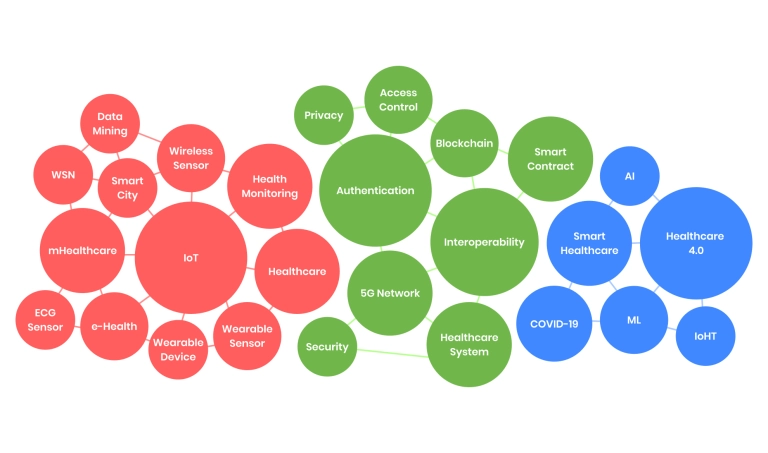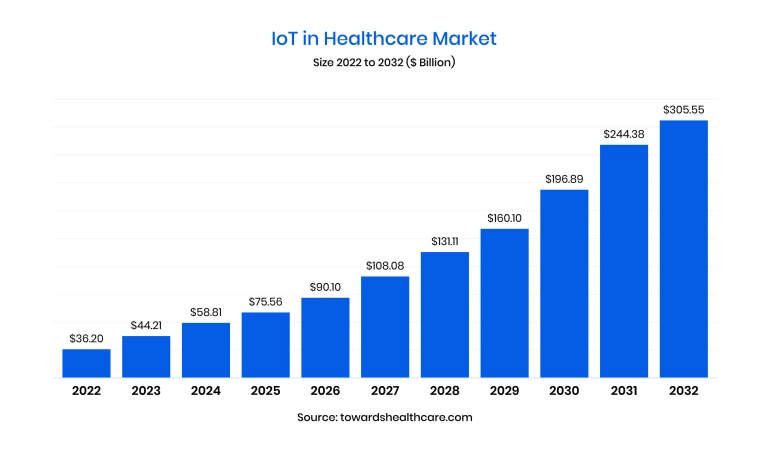The integration of IoT in healthcare is fundamentally changing how healthcare systems operate, improving both the quality of care and patient outcomes. Through connected devices, healthcare professionals are gaining access to real-time data that enhances decision-making and patient monitoring.
From wearable devices that monitor vital signs to smart hospital equipment that tracks conditions in real time, IoT enables connectivity and efficiency never before seen in the industry.
As highlighted in a recent 2023 network analysis on ResearchGate, the rising popularity of IoT in healthcare is reflected in the substantial growth of related keyword searches (Source ):

The reason is that the widespread use of IoT data collection in healthcare streamlines processes, reduces errors, and offers better insights into patient health.
With devices providing continuous, real-time monitoring, healthcare providers can offer more accurate diagnoses, predict potential health risks, and intervene faster. This level of detailed data collection is particularly beneficial for managing chronic conditions and ensuring that care is timely and personalized. IoT data collection for healthcare is therefore playing a critical role in improving both the patient experience and the overall efficiency of healthcare systems.
The growing role of IoT in healthcare
The role of IoT and healthcare has expanded rapidly, with connected devices now playing a pivotal role in both patient care and operational efficiency.
In 2023, the American Hospital Association reported that approximately 74% of patients in the US utilized telehealth services powered by IoT technology, highlighting significant growth and the expanding role of connected devices in the healthcare sector (Source ). Here are some highlights:
- The global IoT in healthcare market size was valued at $44.21 billion in 2023.
- The projected market size is $305.55 billion by 2032.
- It is estimated to grow at 23.4% CAGR.
- By component, the hardware segment dominated the market in 2022 with 58.25% market share.
- By application, telehealth took the lead in 2022 with 36.37% market share.
- By application, surgical robotics will steal the show with the highest 19.7% CAGR from 2023-2032.

One of the most significant impacts of IoT in healthcare is its role in healthcare data collection with IoT. Through devices connected via IoT, healthcare professionals can gather real-time patient data, track health metrics, and monitor vital signs remotely. This constant stream of data is essential for providing personalized care and enabling early intervention, particularly in the management of chronic conditions.
The IoMT is a prime example of how IoT revolutionizes healthcare data collection by connecting medical devices to the internet, facilitating continuous monitoring, and improving patient outcomes.
How IoT enhances healthcare data collection
The relevance of IoT for healthcare in today's world is clear, as it continues to address the challenges of fast and efficient data collection. Manual data entry is becoming increasingly impractical with the massive data generated in healthcare environments. IoT systems solve this problem by automatically capturing large quantities of data in real time, without requiring manual intervention.
As a result, healthcare professionals can focus on providing care rather than spending time on data entry. IoT in medicine offers a streamlined, less intrusive approach that reduces the risk of errors and ensures more accurate, timely data collection.
Non-intrusive data collection
One of the primary benefits of IoT in healthcare is its ability to facilitate non-intrusive data collection. Traditional methods of monitoring patient health may require manual intervention or cumbersome devices that can disrupt the patient's comfort. IoT devices, however, are designed to collect data passively, without requiring the patient or healthcare provider to take extra steps.
For example, wearable sensors and smart devices continuously track patient metrics such as heart rate, blood pressure, and activity levels, all without interrupting the patient's daily routine. This contactless approach improves the patient experience and enhances the accuracy and frequency of the data being collected, allowing for more informed clinical decisions.
So, the key benefits of non-intrusive data collection include:
- Continuous monitoring without disrupting the patient's routine
- Improved accuracy through constant, real-time data collection
- Enhanced patient comfort with minimal physical contact
- Timely data availability for faster decision-making
IoT sensors for automating healthcare operations
IoT sensors are an excellent instrument for automating healthcare operations by capturing and recording data in real-time. These sensors track various activities and conditions, from monitoring patient vital signs to recording actions within a hospital room.
For instance, when a patient moves from one location to another or a healthcare professional interacts with equipment, sensors automatically record these actions and store the data. This automation minimizes the need for manual data entry, ensuring that healthcare workers have immediate access to up-to-date information without the added burden of paperwork or manual logging.
As a result, IoT sensors streamline hospital workflows, reduce human error, and free up healthcare providers to focus more on patient care.
Other applications of IoT in healthcare
The impact of IoT in healthcare is evident in various applications that enhance patient care and operational efficiency. Below are key examples of how IoT in the medical sector is advancing data collection and improving healthcare processes:
Implantable glucose monitoring systems
IoT-enabled glucose monitors provide continuous, real-time tracking of blood sugar levels for patients with diabetes. These devices transmit data to both the patient's mobile app and their healthcare provider, allowing for immediate treatment adjustments if blood sugar levels fall outside the desired range.
By enabling timely interventions, these systems help prevent complications like hypoglycemia or hyperglycemia, leading to better overall management of the condition.
Activity trackers during cancer treatment
Wearable activity trackers are crucial in monitoring the physical well-being of patients undergoing cancer treatment. These devices track physical activity, heart rate, and sleep patterns, offering valuable insights into a patient's recovery process.
Healthcare providers can use this data to tailor cancer treatment plans, adjust medication or therapy based on the patient's physical response, and improve the quality of care.
Heart monitors with reporting
IoT-powered heart monitors provide continuous tracking of heart rate and rhythm, offering early detection of abnormalities like arrhythmias or irregular heartbeats. The data is sent directly to healthcare providers, who can act promptly to prevent any cardiovascular emergencies.
These systems streamline the collection of vital health metrics, providing a more comprehensive picture of the patient’s cardiovascular health and ensuring proactive care.
Medical alert systems
IoT-powered medical alert systems automatically detect critical events, such as falls or sudden changes in a patient's vital signs, and send emergency alerts to their healthcare providers or close ones.
These systems improve patient safety by enabling quick emergency responses and providing peace of mind for patients and caregivers alike. With real-time monitoring, these systems ensure timely interventions are made, reducing risks associated with delayed responses.
Ingestible sensors
Ingestible sensors are small, swallowable medical devices that monitor key health parameters such as drug absorption and body temperature. The sensors transmit data directly to healthcare providers, allowing for real-time tracking of medication effectiveness and ensuring optimal therapeutic outcomes.
These devices provide a non-invasive, efficient method for monitoring patients, especially those with chronic conditions, without requiring frequent hospital visits.
Medication dispensers
IoT medication dispensers automatically track and dispense the correct dosage at scheduled times, ensuring patients adhere to prescribed regimens. These dispensers alert patients or caregivers if a dose is missed, helping to maintain medication compliance and avoid potential health complications.
By streamlining medication management, such devices improve patient adherence and reduce human error in administering medication.
Trackable inhalers
IoT-enabled inhalers provide valuable data on the usage patterns of patients with respiratory conditions, such as asthma or COPD. These inhalers track when and how often the device is used and send the data to healthcare providers, ensuring that patients adhere to prescribed treatment plans.
The insights gained from this data help healthcare providers assess the effectiveness of the treatment and make necessary adjustments to optimize respiratory care.
Remote monitoring
IoT in the medical field enables remote monitoring systems that collect and transmit health data from patients at home or other off-site locations. These systems allow healthcare providers to remotely monitor chronic conditions or post-surgery recovery, reducing the need for in-person visits.
Real-time data collection enables timely interventions, ensuring patients receive the necessary care without unnecessary delays or hospital visits.
From concept to deployment—IoT solutions done right
Our expertise in IoT solutions for healthcare
The rise of IoT in healthcare is reshaping patient care, hospital management, and medical research. Connected devices are enabling real-time health monitoring, predictive analytics, and automated workflows, reducing hospital readmissions and improving patient outcomes.
From wearable ECG monitors to smart hospital beds and AI-driven diagnostics , IoT is driving a data revolution in healthcare. However, security, interoperability, and scalability remain critical challenges. A fragmented tech ecosystem can lead to inefficiencies, while data breaches pose serious risks. This is where expert-driven solutions make all the difference.
At Binariks, we help healthcare organizations build and deploy secure, scalable IoT ecosystems tailored to their unique needs. Whether it's real-time remote monitoring, predictive maintenance for medical devices , or seamless EHR integrations , we ensure your IoT solutions are compliant, reliable, and future-ready.
Let's bring the future of connected healthcare to life—together. Ready to implement smart healthcare solutions? Contact our experts today.
Share

